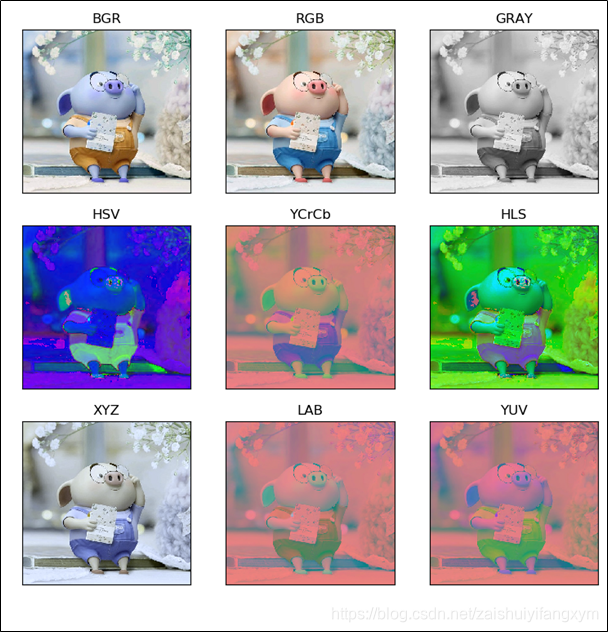Cv2 Rgb To Gray
Def channelconvert(inc, tartype, imglist): # conversion among BGR, gray and y if inc 3 and tartype 'gray': # BGR to gray graylist = cv2.cvtColor(img, cv2.COLORBGR2GRAY) for img in imglist return np.expanddims(img, axis=2) for img in graylist elif inc 3 and tartype 'y': # BGR to y ylist = bgr2ycbcr(img, onlyy=True. Grayimg2 = cv2.cvtColor(pic2,cv2.COLORBGR2GRAY) return (grayimg1,grayimg2) # function to detect the features by finding key points and descriptors from the image. CvtColor function in OpenCV is very helpful in converting color channels from one to another such as BRG to HSV or BRG to RGB. The same method can be used to convert BRG to GRAY by using the cv2.cvtColor (img,cv2.BGR2GRAY). Img1 = cv2.cvtColor(img, cv2.COLORGRAY2BGR) img2 = contoursimg # Create a mask of contours and create its inverse mask also img2gray = cv2.cvtColor(img2,cv2.COLORBGR2GRAY) ret, mask = cv2.threshold(img2gray, 10, 255, cv2.THRESHBINARY) maskinv = cv2.bitwisenot(mask) # Now black-out the area of contours in original image img1bg = cv2.
“opencv rgb to gray custom” Code Answer’s. Bgr2gray opencv. Whatever by Hilarious Hamerkop on Apr 30 2020 Donate. Cv2 turn rgb image to grayscale.
Convert RGB to gray / other color spaces
| Parameters: |
|
|---|
Cv2 Rgb To Gray Converter
This function converts one image from one colorspace to another.The default color format in openCV is RGB.But is is actually BGR(byte reversed).so in an 24 bit color image the first 8 bits are blue components,2nd byte is green and third one is red.- 0 to 255 for CV_8U images
- 0 to 65535 for CV_16U images
- 0 to 1 for CV_32F images
Example:
Steps:
- Load an image
- Convert to gray scale
- Show result
------------------------------------------
-------------------------------------------
Question or problem about Python programming:
I’m learning image processing using OpenCV for a realtime application. I did some thresholding on an image and want to label the contours in green, but they aren’t showing up in green because my image is in black and white.
Early in the program I used gray = cv2.cvtColor(frame, cv2.COLOR_BGR2GRAY) to convert from RGB to grayscale, but to go back I’m confused, and the function backtorgb = cv2.cvtColor(gray,cv2.CV_GRAY2RGB) is giving:
The code below does not appear to be drawing contours in green. Is this because it’s a grayscale image? Sonic r free. download full version for pc. If so, can I convert the grayscale image back to RGB to visualize the contours in green?
How to solve the problem:

Solution 1:
I am promoting my comment to an answer:
The easy way is:
You could draw in the original ‘frame’ itself instead of using gray image.
The hard way (method you were trying to implement):
backtorgb = cv2.cvtColor(gray,cv2.COLOR_GRAY2RGB) is the correct syntax.
Solution 2:
Try this:
I discovered, while using opencv, that some of the constants are defined in the cv2 module, and other in the cv module.
Solution 3:
One you convert your image to gray-scale you cannot got back. You have gone from three channel to one, when you try to go back all three numbers will be the same. So the short answer is no you cannot go back. Gibbed save editor for mass effect 2. The reason your backtorgb function this throwing that error is because it needs to be in the format:
OpenCV use BGR not RGB, so if you fix the ordering it should work, though your image will still be gray.
Solution 4:
Alternatively, cv2.merge() can be used to turn a single channel binary mask layer into a three channel color image by merging the same layer together as the blue, green, and red layers of the new image. We pass in a list of the three color channel layers – all the same in this case – and the function returns a single image with those color channels. This effectively transforms a grayscale image of shape (height, width, 1) into (height, width, 3)
To address your problem
Cv2 Rgb To Gray Color Chart
I did some thresholding on an image and want to label the contours in green, but they aren’t showing up in green because my image is in black and white.
Opencv Rgb To Gray
This is because you’re trying to display three channels on a single channel image. To fix this, you can simply merge the three single channels
Cv2 Rgb To Grayscale
Example
We create a color image with dimensions (200,200,3)
Next we convert it to grayscale and create another image using cv2.merge() with three gray channels

We now draw a filled contour onto the single channel grayscale image (left) with shape (200,200,1) and the three channel grayscale image with shape (200,200,3) (right). The left image showcases the problem you’re experiencing since you’re trying to display three channels on a single channel image. After merging the grayscale image into three channels, we can now apply color onto the image
Full code